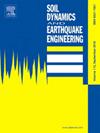Seismic analysis and design of multi-tiered steel eccentrically braced frames with built-up tubular links
IF 4.2
2区 工程技术
Q1 ENGINEERING, GEOLOGICAL
引用次数: 0
Abstract
This paper evaluates seismic stability of multi-tiered steel eccentrically braced frames (EBFs) with build-up tubular shear links, emphasizing on the stability response of intermediate beams and columns, and proposes a seismic analysis and design method to enhance their stability response. The stability response of multi-tiered EBFs is heavily influenced by progressive yielding of intermediate link beams, out-of-plane deformation of unbraced intermediate beams, and column out-of-plane response. The proposed analysis and design method includes i) lateral bracing requirements for diagonal braces by considering the out-of-plane stiffness and strength of intermediate beams, ii) requirements to laterally brace intermediate beams at their ends by leveraging column out-of-plane stiffness and strength, iii) requirements to check the strength and stability of columns under combined axial force, in-plane and out-of-plane flexural demands, and iv) guidelines to control inelastic link rotation at each tier by utilizing in-plane flexural stiffness of the columns. Nonlinear static and dynamic analyses are conducted to evaluate the seismic response of multi-tiered EBFs and validate the proposed design method. The results confirm that the frames not designed to the proposed requirements may experience instability in intermediate beams and columns. EBFs designed in accordance with the proposed method better distribute the inelastic lateral deformation between tiers, and exhibit lower inelastic link rotations satisfying the allowable inelastic rotation for shear links. Finally, column in-plane and out-of-plane flexural demands are predicted with sufficient accuracy.
求助全文
约1分钟内获得全文
求助全文
来源期刊

Soil Dynamics and Earthquake Engineering
工程技术-地球科学综合
CiteScore
7.50
自引率
15.00%
发文量
446
审稿时长
8 months
期刊介绍:
The journal aims to encourage and enhance the role of mechanics and other disciplines as they relate to earthquake engineering by providing opportunities for the publication of the work of applied mathematicians, engineers and other applied scientists involved in solving problems closely related to the field of earthquake engineering and geotechnical earthquake engineering.
Emphasis is placed on new concepts and techniques, but case histories will also be published if they enhance the presentation and understanding of new technical concepts.
 求助内容:
求助内容: 应助结果提醒方式:
应助结果提醒方式:


